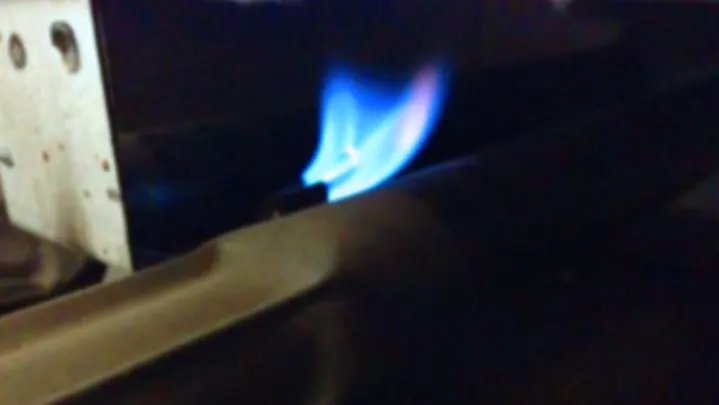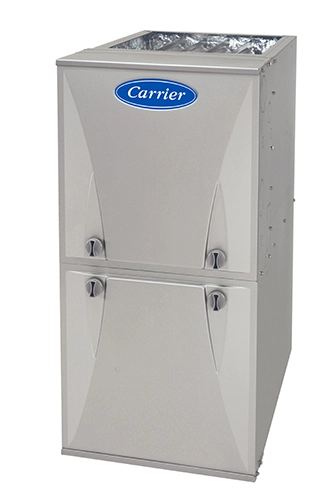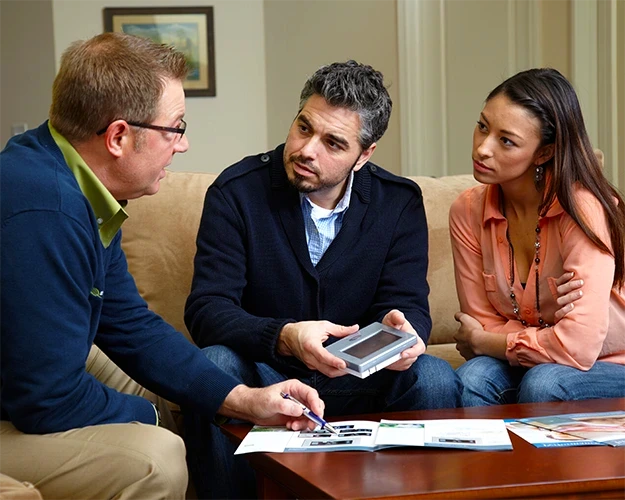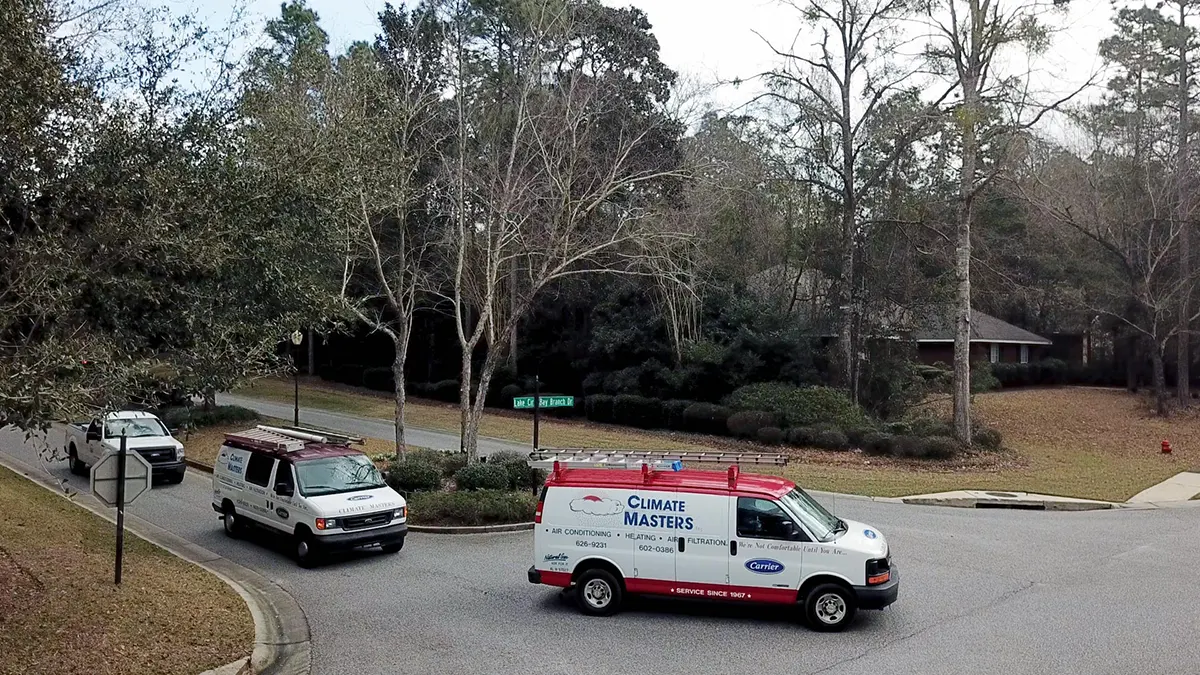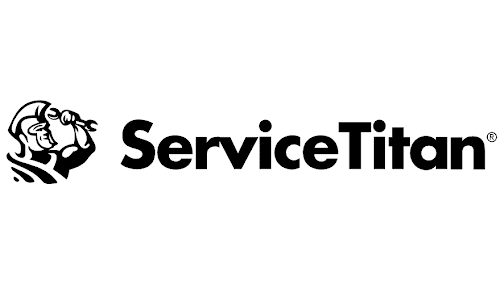Homeowners may find gas furnace repair to be a perplexing and complicated procedure. Even if they have experience in DIY, it can still be challenging to comprehend the intricacies of the system and identify the root cause of the issue. We can use our expertise to make sure your gas furnace operates efficiently and reliably, relieving you of concerns about unforeseen malfunctions or expensive repairs.
Common Issues with Gas Furnaces
Gas furnaces, while reliable, can sometimes run into problems. The most frequently reported issue is a dirty or clogged air filter. When filters become congested with dust and debris, airflow is restricted, leading to reduced efficiency and potential overheating.
Other issues include:
- Faulty Ignition Systems: Problems with the ignitor or pilot light can prevent the furnace from starting, leaving you in the cold.
- Ductwork Troubles: Leaks or blockages in the ducts can cause heat distribution problems, leading to uneven heating throughout your home.
- Blower Malfunctions: If the blower components are damaged, the system cannot effectively circulate warm air.
- Flame Sensor Replacement: A damaged or dirty flame sensor may fail to detect a flame, causing the system to shut down as a safety measure.
- Cracked Heat Exchangers: This serious issue can result in dangerous gas leaks, posing safety hazards.
By ensuring your furnace is regularly maintained, many of these problems can be detected early and resolved before they cause significant disruptions.
What Should I Do If I Smell Gas Around My Furnace?
Smelling gas inside your home can be alarming, and immediate action is crucial to ensure your safety. Here’s a step-by-step guide on what to do:
- Shut Off the Gas Supply: Locate the gas valve near your furnace and turn it off to halt any further gas flow.
- Ventilate the Area: Open all doors and windows to disperse any accumulated gas, reducing the risk of inhalation or explosion.
- Evacuate Immediately: Leave your home immediately with all occupants. Do not turn on any electrical appliances or use matches, as sparks could ignite the gas.
- Call a Professional: From a safe location, contact a licensed professional or your local gas company to inspect your system. It’s possible there may be issues such as a leaking gas line, a malfunctioning gas valve, or a cracked heat exchanger that require expert attention.
By following these steps, you can ensure your safety while addressing potential hazards promptly.
Common Gas Furnace Problems Indicating the Need for Repair
Is your gas furnace acting up? Several issues might suggest it’s time for a professional check-up:
- Inconsistent Room Temperatures: If your home feels like a patchwork quilt of warm and cold spots, there’s likely an issue with your furnace’s efficiency or air distribution.
- Rising Utility Bills: Notice your energy bills soaring without explanation? A malfunctioning furnace often works harder than it should, consuming more energy in the process.
- Reduced Airflow: Weak airflow from your vents could point to a clogged filter, blocked ducts, or issues with the blower fan.
- Unusual Noises: Clanking, banging, or rattling sounds are not typical. These noises might indicate anything from loose components to a failing blower motor.
- Odd Odors: Strange smells, whether they’re musty or metallic, can signal problems ranging from dirty burners to potentially dangerous leaks.
If you’re experiencing any of these problems, it’s wise to contact a certified technician to assess and address any issues before they escalate. Regular maintenance can prevent small problems from becoming big headaches—ensuring your furnace heats efficiently and safely.
When repairing a gas furnace, it is important to be efficient and skilled. A repair may involve both simple and intricate tasks. At Climate Masters Inc., our team of experts recognizes the value of efficiency in the repair process.
However, there are specific situations when calling a professional is not just wise but necessary:
- Smelling Gas: If you detect a gas odor, it’s crucial to shut off the gas supply immediately, ventilate your home by opening doors and windows, and exit the premises. This could indicate a serious issue such as a failed gas line, a faulty gas valve, or a cracked heat exchanger.
- Heat Exchanger Issues: Look for signs like soot buildup inside the furnace cabinet, strong unusual smells, or visible corrosion, which suggest a cracked or failing heat exchanger that needs professional attention.
- Faulty Gas Valve: If your furnace is cycling on and off irregularly, failing to produce heat, or triggering the CO detector, a faulty gas valve could be the culprit.
- Failing Control Board: Should your furnace struggle to start, frequently cycle its burners, or emit a burning smell, the control board might be failing.
Identifying these issues promptly can prevent further damage and ensure your home’s safety. Trusting experts ensures that both straightforward and complex repairs are handled with precision, maintaining the efficiency and longevity of your system.”
Our services cover both basic maintenance and intricate repair requirements to make sure that your gas furnace is running at its best. Here’s a more detailed look at the maintenance tasks our experts can perform to ensure your system operates efficiently and safely:
- Clean or Replace the Air Filter: Keeping the air filter clean or replacing it regularly is vital for maintaining air quality and efficiency.
- Test the Thermostat: Ensuring your thermostat functions correctly helps maintain a comfortable temperature without wasting energy.
- Heating Output Check: We’ll measure the heating output and return air temperatures, ensuring optimal performance in heating mode.
- Burner and Igniter Maintenance: Cleaning and checking the burner, crossover, and igniter are crucial for consistent operation.
- Gas Valve Adjustment: Our experts will check and adjust the gas valve to maintain safe and efficient gas flow.
- Pilot Light System: On older models, we clean and tune the pilot light system to prevent malfunctions.
- Heat Exchanger Inspection: By cleaning the heat exchanger and inspecting for cracks, corrosion, or leaks, we ensure safe operation.
- Blower Assembly Care: We inspect and clean the blower assembly and motor to maintain optimal airflow and efficiency.
- Wiring Inspection: High temperatures can damage wiring; we conduct thorough inspections to prevent potential hazards.
- Flue Pipe and Ductwork: Inspecting the condition of these components helps maintain system integrity and safety.
- Gas Line and Fuel Supply Check: We perform leak checks on the gas line and fuel supply components to ensure everything is secure.
Incorporating these detailed maintenance steps ensures your furnace not only runs smoothly but also lasts longer, providing you with warmth and peace of mind throughout the colder months.
Why Might My Gas Furnace Not Be Providing Heat?
If your gas furnace isn’t delivering heat, several factors could be responsible. Here’s what you should consider:
- Thermostat Issues
Start by checking your thermostat. Ensure it’s set to “heat” and the temperature setting is higher than the current room temperature. A malfunctioning thermostat might need new batteries or a complete replacement. - Clogged Filters
Air filters that are dirty or clogged can restrict airflow, causing the furnace to shut down or operate inefficiently. It’s crucial to replace these filters regularly to maintain proper airflow and efficiency. - Ignition or Pilot Light Problems
Furnaces rely on an ignition system or a pilot light to start. If these are faulty, your furnace won’t kick in. Inspect the pilot light to see if it’s lit. If not, it may require cleaning or professional repair. - Gas Supply Issues
A disruption in the gas supply can prevent your furnace from working. Check that the gas valve is open and that there are no leaks in the system. - Faulty Components Components like the heat exchanger, blower motor, or limit switch can malfunction or fail over time. If you suspect a component issue, contact a professional technician for a thorough diagnostic check and necessary repairs.
- Tripped Circuit Breakers
Your furnace requires electricity to run. Check your home’s circuit breaker for any tripped switches that might be preventing the furnace from operating.
By inspecting these potential issues, you can often pinpoint why your furnace isn’t providing heat and take the necessary steps to restore warmth to your home. If these checks don’t resolve the problem, it’s advisable to contact a qualified HVAC technician for a comprehensive assessment.
What Causes Strange Noises or Smells from a Gas Furnace?
If you’re noticing odd sounds or unusual odors coming from your gas furnace, it’s essential to address the issue promptly. Here are some potential causes:
Strange Noises
- Banging or Popping: This could indicate expanding and contracting air ducts or that dust and debris have settled in the furnace burners, causing delayed ignition.
- Squealing or Whining: High-pitched noises often point to issues with the blower belt or bearings and should be checked before they worsen.
- Rattling or Clinking: Loose panels or components can be the culprits. Tightening the screws or securing loose parts often resolves the issue.
Unusual Smells
- Musty Odor: This typically signals mold growth within the furnace system, potentially due to excessive humidity or condensation buildup.
- Burning Smell: If you catch a whiff of something burning, it might be dust accumulation on the burners or heat exchanger. Burning could also indicate electrical trouble, so it’s best to have a professional take a look.
- Rotten Egg Smell: This is a critical warning sign of a natural gas leak. Natural gas is odorless, but suppliers add a sulfur-like smell to help detect leaks early. If you notice this, evacuate immediately and contact emergency services.
Regular maintenance and professional inspections can help prevent these issues and ensure your furnace operates safely and efficiently. If you’re uncertain about any noise or smell, it’s always wise to consult a professional technician to avoid further damage or hazards.
Troubleshooting Tips for a Gas Furnace Running but Not Heating
If your gas furnace is running but failing to provide heat, there are a few common issues you can check to potentially resolve the problem:
- Inspect the Thermostat Settings:
Start by examining the thermostat settings. Ensure it is switched to the ‘heat’ mode and the temperature is set higher than the current room temperature. - Examine the Furnace Power Switch:
Look for the power switch located on or near the furnace unit. It should be in the “on” position. This switch sometimes gets turned off accidentally. - Check the Circuit Breaker:
Go to your home’s electrical panel and verify that the circuit breaker for the furnace hasn’t been tripped. If it has, reset it by turning it off and then back on.
By systematically checking these areas, you might identify a simple issue stopping your furnace from heating. If these steps don’t solve the problem, it could be time to contact a professional for further inspection.
How Can I Troubleshoot My Gas Furnace Before Calling a Technician?
Before you pick up the phone to call a technician for your gas furnace issues, there are several steps you can take to troubleshoot the problem yourself. This approach can often save time and money by resolving minor issues on your own. Here’s how you can ensure your furnace is operating as it should:
1. Inspect the Thermostat and Circuit Breaker
- Verify Settings: Double-check that your thermostat is set to ‘heat’. A simple oversight here can lead to unnecessary confusion.
- Check Power Supply: If the furnace isn’t operational, confirm that the power switch on the side of the furnace is turned on. Also, inspect your circuit breaker panel to ensure the appropriate breaker hasn’t been tripped.
2. Evaluate the Furnace Filter
- Examine the Filter: A dirty filter can impede airflow, leading to higher energy consumption and strain on the blower motor. Regularly cleaning or replacing the filter according to the manufacturer’s instructions is crucial for optimal performance.
3. Ensure Open Heat Registers
- Check Vents: Make sure that all heat registers are open and not blocked by furniture or other obstructions. If accessible, remove vent covers to check and clean any dusty ductwork.
4. Secure the Cabinet Access Panel
- Reattach After Inspection: If you’ve removed the access panel for any reason, ensure it is securely replaced. Not doing so can prevent the furnace from operating due to safety features.
5. Examine Air Intake and Exhaust Vents
- Check for Blockages: Look for any obstructions in your system’s air intake and exhaust vents outside the home. Whether you have PVC or metal vents, it’s vital to keep them clear to avoid harmful carbon monoxide buildup.
6. Relight the Pilot Light
- Ignite the Pilot: For older models with a standing pilot light, ensure the pilot is lit. Follow the manufacturer’s guidelines carefully to relight it safely if it’s gone out, as this is necessary for the burners to ignite and provide heat.
Taking these steps can often resolve simple issues without the need for professional assistance. However, if problems persist after trying these measures, contacting a qualified technician may be necessary to address more complex problems.
Understanding the Pilot Light in Older Gas Furnaces
A pilot light is a small, continuously burning flame found in many older gas furnaces. Its primary role is to ignite the burners when the furnace is activated, ensuring your home stays warm and comfortable.
Why is the Pilot Light Important?
- Ignition Source: The pilot light serves as the fundamental ignition source for the furnace. When functioning properly, it lights the gas burners, allowing the furnace to heat your home efficiently.
- Safety Mechanism: A working pilot light prevents the risk of gas buildup in the furnace. If the pilot light goes out, the gas valve is designed to stop gas flow to the burners, reducing the danger of gas leaks.
- Reliability in Older Systems: Many older furnaces rely on a standing pilot light. In these systems, the pilot must remain lit for the furnace to operate. Without it, the entire heating mechanism is compromised.
What Happens When the Pilot Light Goes Out?
When a pilot light goes out, the furnace loses its ability to ignite the burners. This means the system cannot produce heat, leaving you with a cold home. It is crucial to follow specific manufacturer instructions to relight the pilot safely. This ensures effective and safe furnace operation.
Understanding the role of the pilot light in older gas furnaces highlights its importance in maintaining both warmth and safety in your home.
What Could Cause a Gas Furnace to Cycle On and Off Frequently?
If your gas furnace is turning on and off repeatedly, this could indicate several potential problems. Let’s explore some common culprits:
- Faulty Gas Valve: A malfunctioning gas valve can disrupt the flow of gas to the burner, leading to inconsistent heating cycles.
- Thermostat Issues: Incorrect thermostat settings or a malfunctioning unit can cause the furnace to turn on and off intermittently. Ensure it’s calibrated correctly and functioning properly.
- Clogged Filter: An obstructed air filter can restrict airflow, causing the furnace to overheat and shut off as a safety precaution. Regularly replacing or cleaning your air filters can help prevent this.
- Blocked Vents: If the vents are blocked or closed, this can lead to pressure imbalances, prompting the furnace to cycle irregularly.
- Overheating: The furnace could be overheating due to insufficient airflow or mechanical issues, triggering an automatic shutdown to prevent damage.
- Improper Size: A furnace that is too large for the space might heat the area too quickly and shut off, only to start again when the temperature drops rapidly.
By addressing these issues, you can help ensure your furnace operates more efficiently and reduce unnecessary wear and tear on the system.
How can I check if my furnace filter needs cleaning or replacement?
Checking your furnace filter regularly is essential for maintaining an efficient heating system. Here’s how to assess whether it needs cleaning or replacement:
- Inspect the Filter: Safely turn off your furnace and locate the filter. Typically, it’s housed near the blower compartment or within the return air duct. Gently slide it out and examine the surface.
- Examine for Dirt and Debris: Hold the filter up to a light. If you can’t easily see light passing through, it’s likely clogged with dust and debris. A filter loaded with dust not only impacts airflow but also forces your system to work harder, potentially increasing energy costs.
- Note Unusual Changes: Pay attention to your home’s dust levels, unusual furnace noises, or elevated energy bills. These can be early signs that the filter is clogged.
- Follow Usage Guidelines: Check the manufacturer’s recommendations on how often to replace the filter. Common advice is replacing it every 1-3 months, but this can vary based on factors like usage, pets, or allergy concerns.
- Consider Filter Type: If you have a reusable filter, rinse it thoroughly with water and allow it to dry before reinserting. Disposable filters, on the other hand, should be completely replaced as needed.
By keeping your filter clean, you ensure optimal heating performance, lower energy consumption, and a more comfortable home environment. Regular maintenance is key to a healthy furnace and home.





